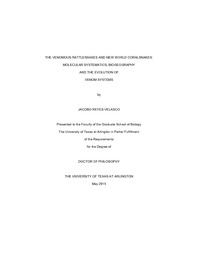
ATTENTION: The works hosted here are being migrated to a new repository that will consolidate resources, improve discoverability, and better show UTA's research impact on the global community. We will update authors as the migration progresses. Please see MavMatrix for more information.
Show simple item record
| dc.contributor.author | Reyes Velasco, Jacobo | en_US |
| dc.date.accessioned | 2015-12-11T23:19:59Z | |
| dc.date.available | 2015-12-11T23:19:59Z | |
| dc.date.submitted | January 2015 | en_US |
| dc.identifier.other | DISS-13229 | en_US |
| dc.identifier.uri | http://hdl.handle.net/10106/25330 | |
| dc.description.abstract | Middle America is one of the most biologically diverse regions in the world, however it is also one with some of the highest rates of biodiversity loss. Reptiles are especially diverse in this region, and are a very important component of the area, from a biological as well as a cultural perspective. In Mexico and Central America venomous snakes are the most studied group of reptiles, as they are of great ecological and medical importance. Despite this, our understanding of the evolutionary relationships in many groups of venomous snakes is limited. Understanding these relationships is no ludicrous matter as it is fundamental to appropriately answer evolutionary questions. Herein I examine the systematic relationships of the two most diverse lineages of venomous snakes in Middle America, the rattlesnakes (genus Crotalus) and the coral snakes (genus Micrurus). In particular, I studied the phylogenetic relationships of an obscure lineage of rattlesnakes, the longtailed rattlesnakes, as well as the phylogeny and species limits of coral snakes in the diastema species complex of the genus Micrurus. I used nuclear and mitochondrial genes to test if the longtailed rattlesnakes form a monophyletic group and to estimate their closest relatives within the genus. By doing so, I provide the most robust molecular phylogeny for the rattlesnakes to date. Relationships among coral snakes are known to be difficult to estimate with the use of DNA markers obtained from traditional sequencing techniques. Because of this, I use a combination of traditional sequencing of mitochondrial DNA and next generation sequencing (in the form of double digest restriction associated DNA sequencing, ddradseq), in order to elucidate evolutionary relationships and species limits in the diastema species complex of coral snakes. Lastly, I made use of the Burmese python genome as a proxy to understand how non-venom genes became recruited into venom systems in the most recent ancestor of both coral snakes and rattlesnakes. | en_US |
| dc.description.sponsorship | Castoe, Todd | en_US |
| dc.language.iso | en | en_US |
| dc.publisher | Biology | en_US |
| dc.title | The Venomous Rattlesnakes And New World Coral Snakes: Molecular Systematics, Biogeography And The Evolution Of Venom Systems | en_US |
| dc.type | Ph.D. | en_US |
| dc.contributor.committeeChair | Castoe, Todd | en_US |
| dc.degree.department | Biology | en_US |
| dc.degree.discipline | Biology | en_US |
| dc.degree.grantor | University of Texas at Arlington | en_US |
| dc.degree.level | doctoral | en_US |
| dc.degree.name | Ph.D. | en_US |
Files in this item
- Name:
- ReyesVelasco_uta_2502D_13229.pdf
- Size:
- 92.19Mb
- Format:
- PDF
This item appears in the following Collection(s)
Show simple item record


